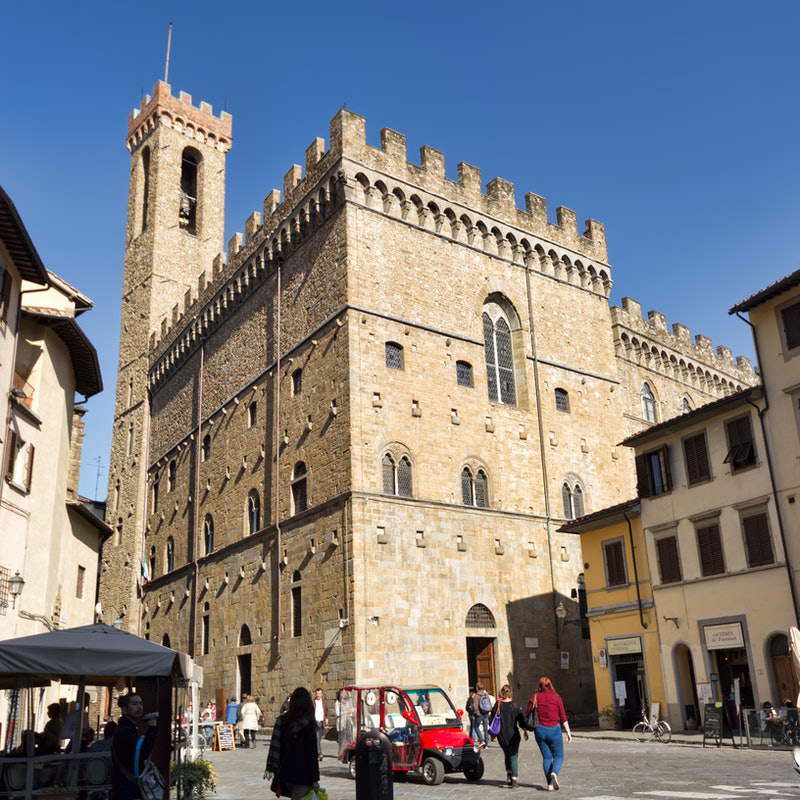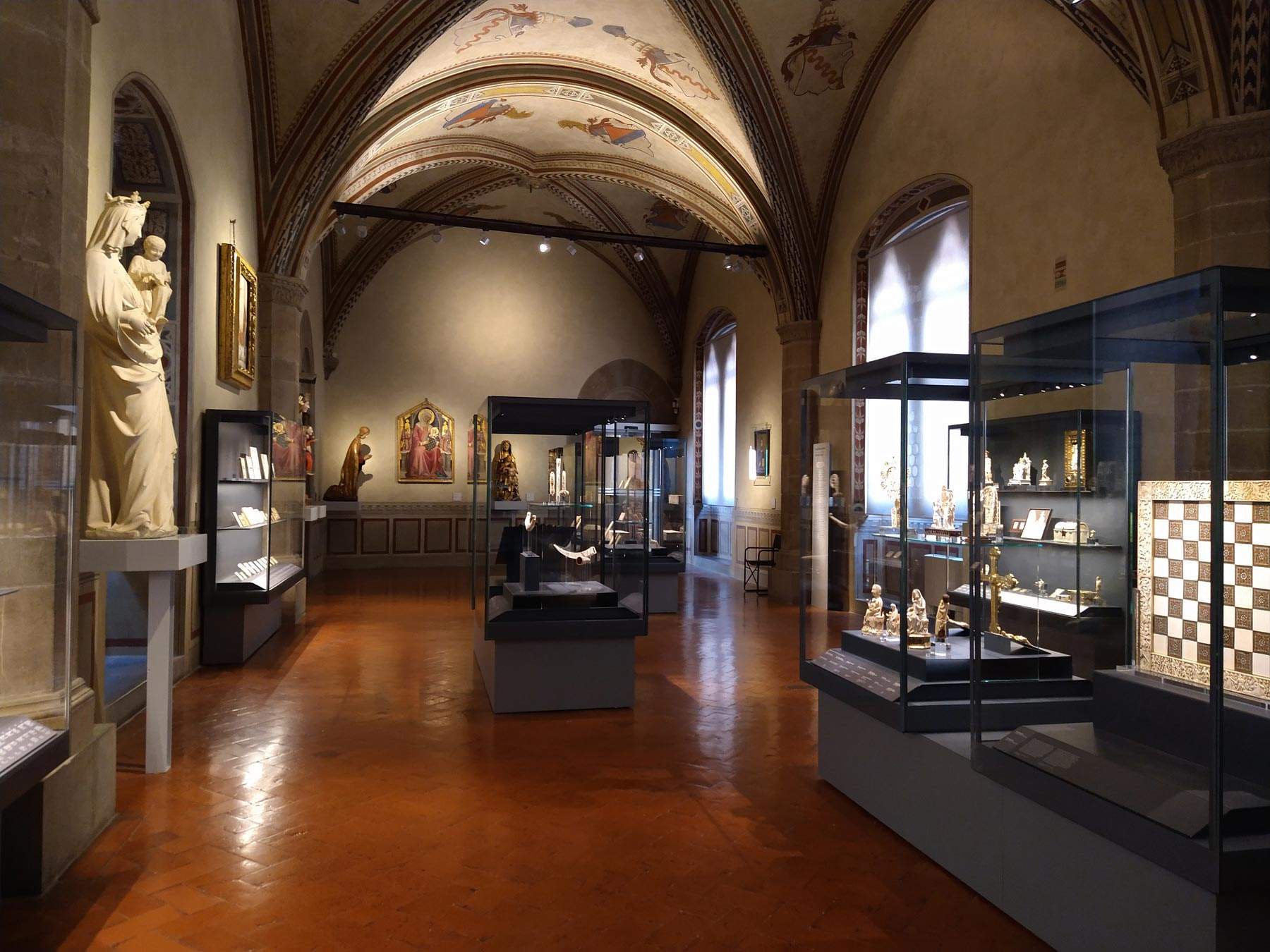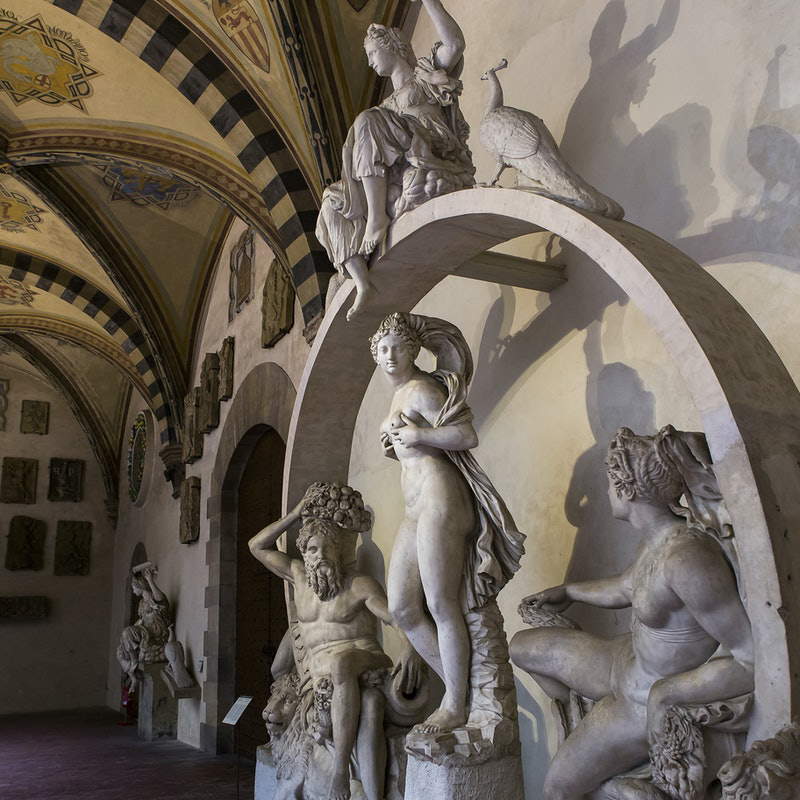It remains somewhat off the tourist track in Florence, but in terms of importance its collection is among the most important not only in the city, but in all of Italy: it is the Bargello National Museum, home to one of the most important collections of medieval and Renaissance sculpture in the country and beyond. Visited each year by more than 200.000 visitors, the Bargello Museum includes masterpieces by Michelangelo, Donatello, Giambologna, Benvenuto Cellini, Bartolomeo Ammannati and many other great artists.Moreover, the building itself, the Palazzo del Bargello, is one of Florence’s landmarks: it was in fact the seat of some of the most important institutions of ancient Florence (the podestà, who administered justice, resided here in the thirteenth century, while it was in the sixteenth century that the palace became the seat of the Bargello, or chief of police, so much so that for quite some time part of the building was also used as a prison).
Externally, it still presents itself with its medieval structure: an austere three-story main body with mullioned windows along the second floor and a Guelph battlement surmounting it, flanked by the tower, the Volognana, 57 meters high. Inside, there is a porticoed courtyard with round arches on octagonal pillars, dating from the 13th century: the walls are decorated, as was the custom in medieval Tuscany, with the coats of arms of the podestà. Around the courtyard are the museum rooms, on the first floor and second floor (the latter connected to the courtyard by the monumental staircase).
It was in the second half of the 19th century that it was decided to make the Bargello a museum. In 1857, Grand Duke Leopold II decided to empty the palace, which was then a prison (the prisons were moved to the Murate complex), with the idea of transforming the Palazzo del Podestà into a museum, so that the works enclosed in it would illustrate the history of Tuscany. Restorations sought to recover as much as possible of the ancient medieval appearance, and the first works entered for an exhibition in 1861, the year of Italian Unification. The Bargello officially became a museum on June 22, 1865, the date of the royal decree assigning it the role of Italy’s first national museum entirely dedicated to the art of the Middle Ages and Renaissance-a vocation the institute retains to this day. From that date, several works began to flow into its collections: many came from the Medici collections, and in particular from the Palazzo Vecchio and the Uffizi, which had been cleared of several objects since the elevation of Florence to the rank of capital of Italy had placed the need to find venues for the new institutions (the Camera thus found its home in the Palazzo Vecchio, the Senate instead in the Uffizi).
 |
| The Bargello National Museum |
 |
| The courtyard of the Bargello |
 |
| The Hall of the Ivories |
 |
| Giotto ’s Paradise in the Cappella del Podestà |
 |
| Bartolomeo Ammannati’s fountain in the Sala Grande |
 |
| Michelangelo’s Bacchus in the Sala del Cinquecento |
The Bargello’s tour begins in the courtyard itself, where one of the museum’s main masterpieces can be admired, namely Bartolomeo Ammannati’s sculptural group of the Fountain of Sala Grande, leaning against one of the courtyard walls. Going upstairs, the first room one encounters is the Hall of Ivories, which, moreover, has recently been rearranged to better enhance the exceptional collection of ivories that French antiquarian Louis Carrand donated to the museum in 1888 (it is one of the most important of its kind in the world). Immediately after, here comes the Carrand Room, a large hall that houses the antiquarian’s core collection reserved for goldsmithing, metal sculptures (the Islamic artworks in particular are splendid), the Indian art collection, medieval tablets, Limoges enamels (don’t miss the reliquaries), and Murano glass. On the right we enter the Cappella del Podestà, restored on the occasion of the celebrations of the seven hundredth anniversary of Dante Alighieri’s death: it is decorated with frescoes by Giotto (in particular, in the depiction of Paradise, we also find the oldest portrait of the Supreme Poet).
Returning to the Carrand Hall, we continue until we enter one of the most spectacular rooms in the museum, the Hall of the Fifteenth Century, which houses some of the best-known masterpieces in the history of sculpture: there are the works of Donatello (the David in bronze, the David in marble, the St. George, the Marzocco, theAmore-Attis), one admires the Portrait of a Child, the St. John and the Madonna and Child by Desiderio da Settignano, the Battle of Bertoldo di Giovanni that was fundamental for the young Michelangelo, and then again Verrocchio’s David, Luca della Robbia’s glazed terracottas, the panels from the 1401 competition by Filippo Brunelleschi and Lornezo Ghiberti, Mino da Fiesole’s Winged Putto, and Agostino di Duccio’s Madonna and Child. We leave to look out onto the verone, or upper floor loggia, where we see Giambologna’s unique bronze animals from the Villa Medicea di Castello, and continue into the Sala delle Maioliche, where there is a rich collection of Italian and foreign majolica.
The marble David and Verrocchio’s Lady of the Bunch are the masterpieces of the room dedicated to Leonardo da Vinci’s great master.Other important sculptors of the second half of the 15th century, such as Mino da Fiesole, Antonio Rossellino, Matteo Civitali, Benedetto da Maiano, and Francesco Laurana, are also found here. After visiting the Hall of the Small Bronzes (works by Antonio del Pollaiolo, Benvenuto Cellini, Giambologna, and Andrea Briosco known as Riccio stand out), you can end your visit at the large ground-floor hall dedicated to Michelangelo Buonarroti and 16th- and 17th-century sculpture. Michelangelo’s masterpieces, namely the Bacchus, the Pitti Tondo, the David-Apollo, and the Portrait of Brutus, follow one another. Alongside Michelangelo’s works are those of Benvenuto Cellini (there are the small bronzes from the base of the Perseus in Piazza della Signoria, as well as the recently restored bronze bust of Cosimo I), Giambologna (the celebrated Mercury), Tribolo, and Baccio Bandinelli. One can close this journey into great sculpture with the famous and wonderful Portrait of Costanza Bonarelli, a masterpiece by Gian Lorenzo Bernini.
The Bargello Museum is a must-see if you plan a trip to Florence: here is a useful link to buy tickets in advance and skip the queue.
 |
| A journey into the sculpture of the Middle Ages and Renaissance: the Bargello Museum in Florence |
Warning: the translation into English of the original Italian article was created using automatic tools. We undertake to review all articles, but we do not guarantee the total absence of inaccuracies in the translation due to the program. You can find the original by clicking on the ITA button. If you find any mistake,please contact us.